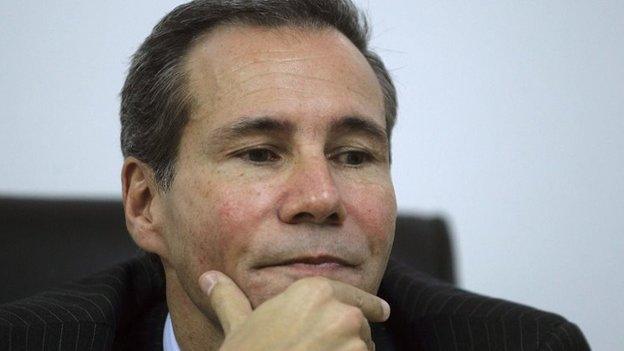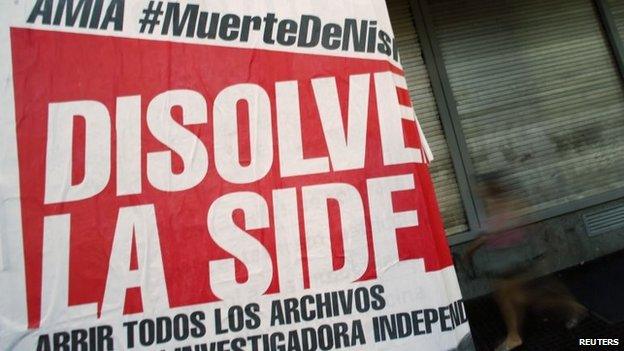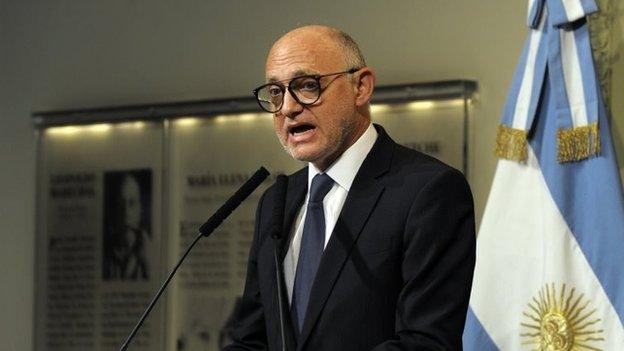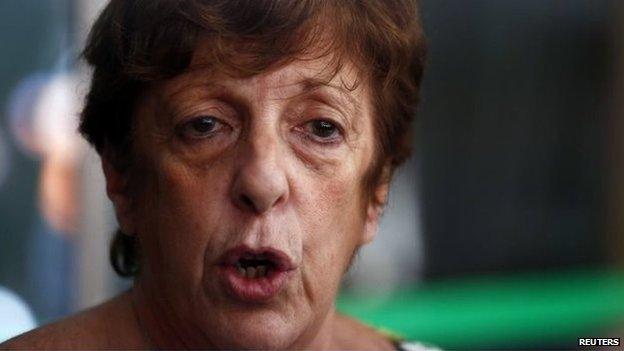Alberto Nisman death: Key players
- Published
Argentine prosecutor Alberto Nisman was found shot dead on 18 January, a pistol by his side.
Mr Nisman had been hours away from outlining his accusations against President Cristina Fernandez de Kirchner at a congressional hearing.
He had been investigating Argentina's worst terrorist attack - a bombing in 1994 that killed 85 people at a Jewish community centre.
As investigators probe his death, we take a look at the key figures.

Alberto Nisman

Mr Nisman had spent 10 years investigating a bomb attack on a Jewish centre
Prosecutor Alberto Nisman, 51, had spent the last 10 years investigating the 1994 bombing of the Amia Jewish centre in Buenos Aires.
Mr Nisman was selected to investigate the bombing by Nestor Kirchner, Argentina's former president and the late husband of current president, Cristina Fernandez.
He was seen as a reinvigorating force and in 2006, he officially accused the Iranian government of directing the bombing. But Iran refused to hand over a number of suspects.
In 2013, the Argentine government reached an agreement with Iran - they would jointly investigate the attack. Some critics felt this was a way of undermining Mr Nisman's investigation.
Days before his death, the prosecutor accused President Fernandez and Foreign Minister Hector Timerman of being involved in a plot to cover up Iran's alleged role in the bombing.
Mr Nisman's body was found by his mother in the bathroom of his home on 18 January.
He had told family members that he was being threatened.
"I might come out of this dead," he told local media on Saturday.
One of his last text messages was a picture of his desk covered in documents as he prepared for the hearing.
There was no suicide note.
His ex-wife, the judge Sandra Arroyo, said on 20 January that she did not believe that he had killed himself.

Cristina Fernandez de Kirchner

President Fernandez said that she was convinced that Mr Nisman's death was not a suicide
President Cristina Fernandez is the widow of former president Nestor Kirchner, who originally selected Mr Nisman to lead the investigation into the bombing.
In his reports, Mr Nisman accused President Fernandez, 61, of taking part in secret negotiations with the Iranians to whitewash their alleged role in the attack.
She denies the allegations but has said that she is "convinced" that Mr Nisman's death was not suicide.
"They used him alive and then they needed him dead," she said in an open letter, external first published on social media [in Spanish].
She did not explain who she thought had killed him but added that his death was "sad and terrible".
Ms Fernandez also published screenshots, external of some of Mr Nisman's messages from his mobile phone.
"It's not going to be easy. On the contrary," he said. "But sooner or later, the truth will come out - and I am very confident."
President Fernandez also said that Mr Nisman had been provided with "false information". She tweeted , externalthat his accusation "not only collapses, but becomes a real political and legal scandal."
She added that Mr Nisman would probably never have known and that the "true operation against the government" was the death of Mr Nisman after his accusation against her and some of her officials.

Antonio Stiusso

Mr Stiusso held a key post in Argentina's Intelligence Secretariat, also known as SIDE
The man knonw as Antonio Stiusso, 61, was director of operations at the Intelligence Secretariat (SI), Argentina's spy agency, until December 2014.
His real name is almost the object of as much speculation as the extent and nature of his links to Mr Nisman.
He is also known under his codename of "Jaime", and has gone under the names of Antonio Horacio Stiles, Aldo Stiles, and The Engineer.
Many just call him "spy chief". There are no official photographs of Mr Stiusso.
He was removed from his post by President Fernandez as part of a wider reshuffle of the leadership of the agency, also known as SIDE.
Mr Stiusso had been an influential figure in the intelligence services since the 1970s.
In 2004, former Justice Minister Gustavo Beliz said of Mr Stiusso: "Everyone is afraid of him, because they say he is very dangerous and can have you killed."
Mr Stiusso was helping Mr Nisman with his investigation into the 1994 Amia bombing and, according to Mr Nisman, had been very forthcoming with information.
But according to President Fernandez, Mr Stiusso withheld key facts from Mr Nisman while feeding him misleading information.
She alleged that Mr Stiusso had failed to inform Mr Nisman that two of his key witnesses were not intelligence agents as Mr Nisman had assumed.
Cabinet Chief Anibal Fernandez also pointed the finger at Mr Stiusso, suggesting he was behind many of the accusations made against the government in Mr Nisman's report.
Mr Fernandez suggested Mr Stiusso was seeking revenge for his removal from the intelligence services, saying the allegations were like "the flailing of a drowning man".
Mr Stiusso has not responded to any of the allegations.

Hector Timerman

Hector Timerman said he believed that the death of Mr Nisman would be resolved
Argentina's Minister of Foreign Relations, Hector Timerman, was also accused by Mr Nisman of being part of the cover-up of Iran's alleged role in the Amia bombing.
Mr Timerman, who is Jewish, also emphatically denies the allegations.
On Monday in New York, he said that he believed that the death of Mr Nisman would be resolved because of Argentina's record in matters of human rights.
He told the local press that: "The death of a young person, in that way, diminishes us all as human beings."
He added that he believed that the investigation into Mr Nisman's allegations would go ahead and that he hoped that those involved would continue their work.

Viviana Fein

Ms Fein said that there had been no outside intervention into Mr Nisman's death
Ms Fein is the prosecutor investigating Mr Nisman's death.
On Monday, she said that there had been "no intervention" from others in his death but that the investigation was ongoing and that she could not rule out that his suicide had been "induced".
She said that the bullet that killed Mr Nisman had come from the gun found lying next to him.
Ms Fein told reporters that the apartment's door had been locked from the inside and that the key was in the lock.
On 22 January, she revealed that a test failed to detect any gunshot residue on Mr Nisman's hands. But she added that the negative result could be due to the small calibre of the gun.
She said that investigators would be test firing the gun to see how much, if any, residue was deposited.
Footprints and fingerprints found in the corridor that links Mr Nisman's apartment to that of a neighbour are also being tested.